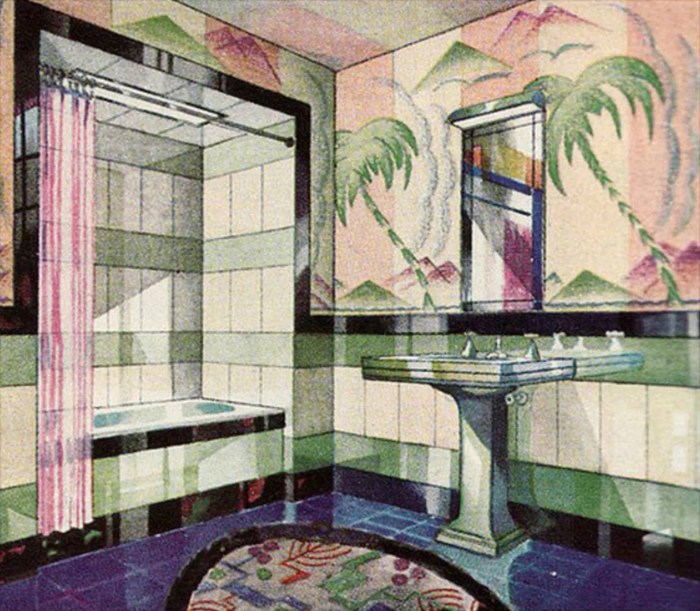Tilework and Wall Treatments: 1920’s Bathroom Decor

1920’s bathroom decor – The bathroom, even in the 1920s, was a space deserving of stylish design. Tilework and wall treatments played a crucial role in achieving the desired aesthetic, reflecting the era’s embrace of geometric patterns, vibrant colors, and luxurious materials. These elements contributed significantly to the overall atmosphere of a 1920s bathroom, transforming it from a purely functional space into a room that showcased the homeowner’s taste and affluence.
Tile Patterns and Colors
Common tile patterns in 1920s bathrooms often featured geometric designs, reflecting the Art Deco influence prevalent during the period. These included repeating motifs such as chevrons, zigzags, and stylized floral patterns. Color palettes frequently incorporated rich, deep tones like navy blue, emerald green, and burgundy, often contrasted with off-white or cream-colored grout. Subtle pastel shades were also employed, particularly in more feminine bathrooms, creating a softer, more delicate look.
Black and white combinations were popular, offering a sophisticated and timeless appeal. The use of color was often bold and dramatic, creating a visually striking effect.
Tile Materials
Ceramic tiles were the most common material used in 1920s bathrooms, offering durability and a wide range of color and pattern options. Glazed ceramic tiles were particularly popular, providing a smooth, easy-to-clean surface. Mosaic tiles, composed of small, individual pieces, were also frequently employed, allowing for intricate designs and detailed patterns. These mosaics could be crafted from ceramic, glass, or even marble, depending on the budget and desired level of luxury.
The choice of material often reflected the overall style of the bathroom, with simpler ceramic tiles used in more modest settings and elaborate mosaics reserved for more opulent spaces.
Wallpaper and Other Wall Coverings
Wallpaper played a significant role in complementing the tilework and establishing the overall aesthetic of the 1920s bathroom. Floral patterns, geometric designs, and Art Deco motifs were all popular choices. The wallpapers often featured bold colors and intricate details, mirroring the patterns found in the tilework. In some instances, the walls might be partially tiled, with wallpaper used to cover the upper sections of the walls, creating a visually interesting contrast between the two materials.
Other wall coverings, such as painted surfaces with decorative stencils or even wood paneling, were also occasionally incorporated, depending on the homeowner’s preferences and the overall design scheme.
Sample 1920s Bathroom Tile Layout, 1920’s bathroom decor
The following bullet points illustrate a potential tile layout for a 1920s-style bathroom:
- Floor: A checkerboard pattern using 6″ x 6″ square tiles in black and white. This classic pattern provides a strong foundation for the overall design.
- Shower Walls: Vertical stripes of 3″ x 12″ rectangular tiles in a deep teal, alternating with narrow strips of off-white grout. The vertical orientation elongates the space and adds a touch of elegance.
- Accent Wall (above the vanity): A geometric pattern of 4″ x 4″ square tiles in a combination of navy blue, cream, and gold. This creates a visually stunning focal point, adding richness and complexity to the design.
- Dado Rail: A horizontal band of 4″ x 4″ square tiles in a contrasting color (e.g., burgundy) separates the lower and upper wall sections, adding a sense of visual structure and proportion.
1920s bathroom decor often featured elegant fixtures and a focus on streamlined designs. The color palettes were varied, but a sophisticated approach often involved incorporating dark accents, which makes a modern connection to the current trend of bathroom decor black and gold quite apparent. This stylish combination, reminiscent of Art Deco influences, continues to inspire contemporary bathroom designs drawing from the 1920s aesthetic.
